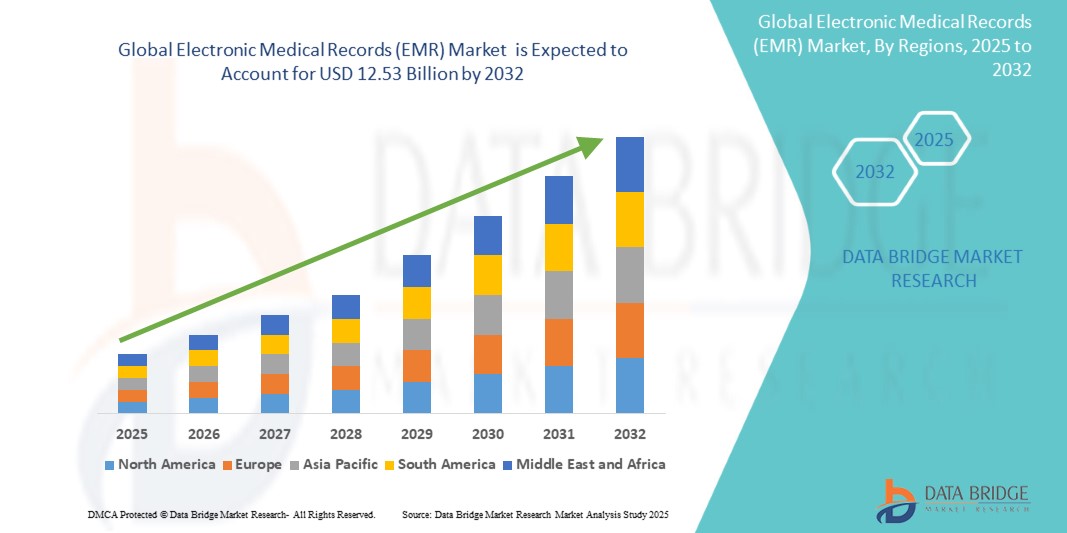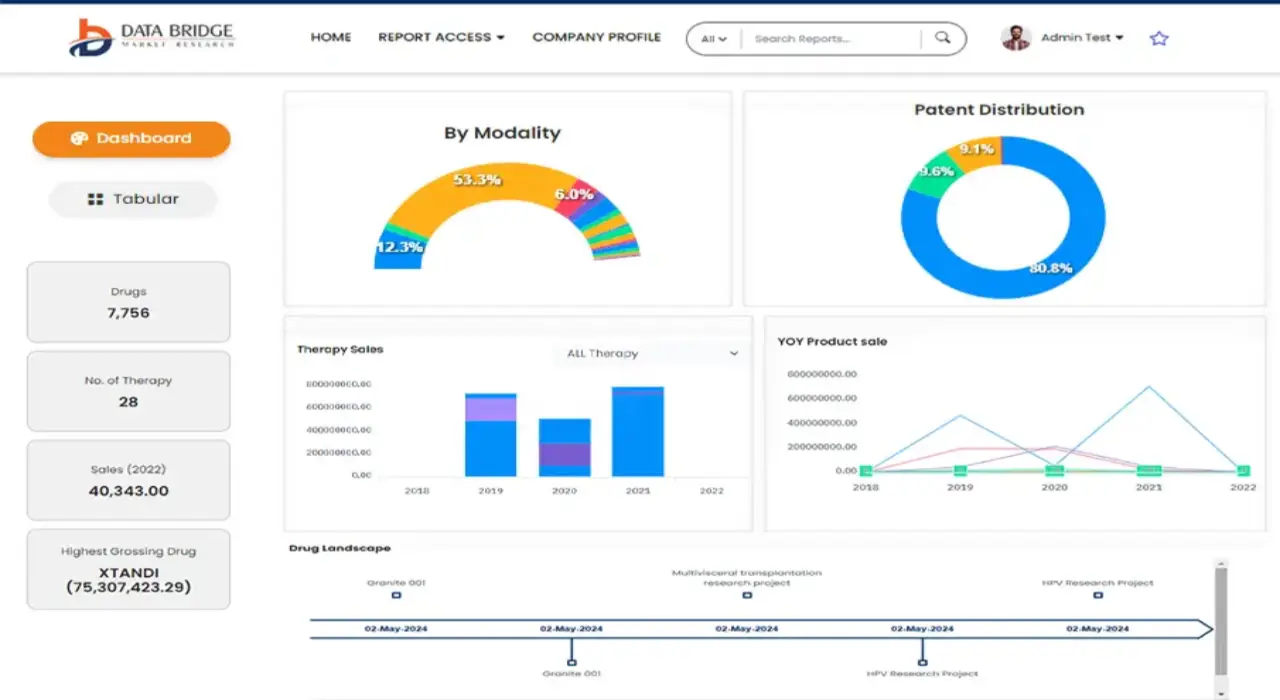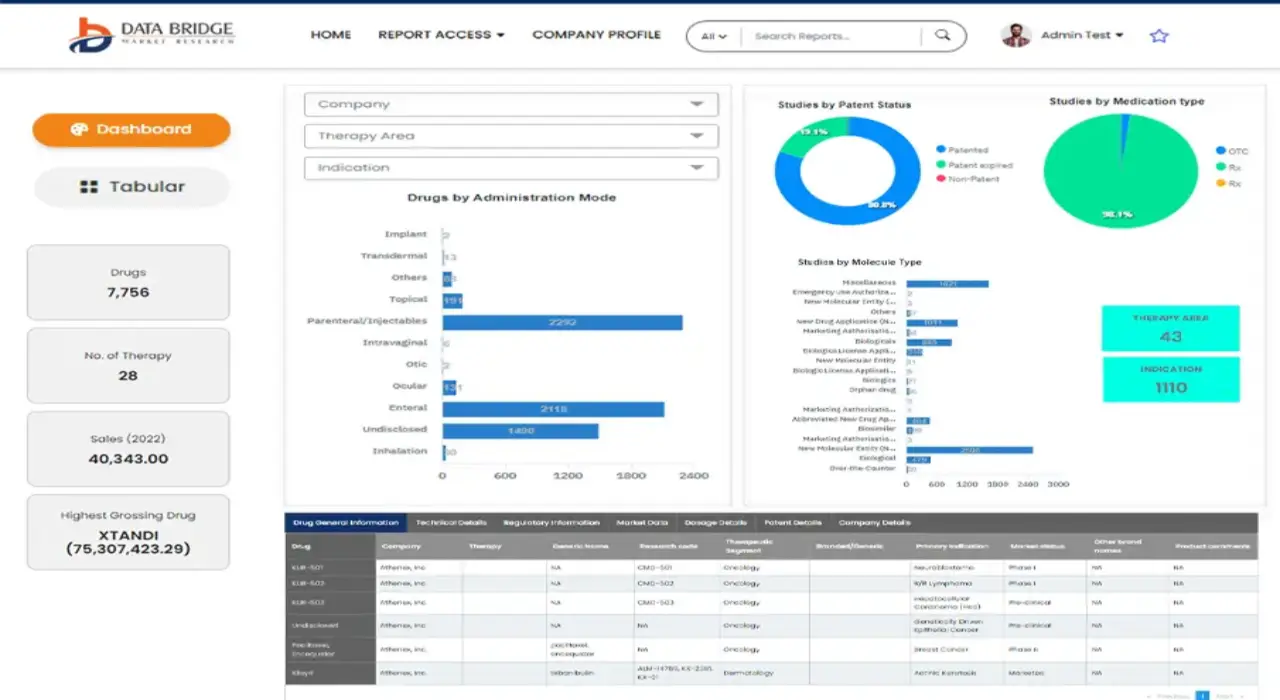Global Electronic Medical Records Emr Market
Tamanho do mercado em biliões de dólares
CAGR :
% 
 USD
7.18 Billion
USD
12.53 Billion
2024
2032
USD
7.18 Billion
USD
12.53 Billion
2024
2032
| 2025 –2032 | |
| USD 7.18 Billion | |
| USD 12.53 Billion | |
|
|
|
|
Global Electronic Medical Records (EMR) Market Segmentation, By Component (Software and Services), Type (Traditional EMR, Speech Enabled EMR, Interoperable EMR, and Others), Application (Specialty Application and General Application), End User (Hospitals, General Physician Clinics, Specialised Clinics,Ambulatory Surgical Centres, and Others), Delivery Mode (Client Based Setups, Cloud Based Setups, and Hybrid Setups) - Industry Trends and Forecast to 2032
Electronic Medical Records (EMR) Market Size
- The global electronic medical records (EMR) market was valued atUSD 7.18 billion in 2024and is expected to reachUSD 12.53 billion by 2032
- During the forecast period of 2025 to 2032 the market is likely to grow at aCAGR of 7.20%,primarily driven by the increasing adoption of digital healthcare
- This growth is driven by factors such as the rising adoption of digital healthcare and rising demand for cloud-based EMR solutions
Electronic Medical Records (EMR) Market Analysis
- Electronic Medical Records (EMR) refer to digital versions of patients' paper charts, containing their medical history, diagnoses, treatment plans, and other healthcare-related information. EMRs are primarily used by healthcare providers to track patient data, ensuring more efficient care, reducing errors, and improving overall healthcare quality
- The global EMR market is experiencing significant growth, projected to expand at a CAGR of 7.20%. This growth is driven by the increasing adoption of digital healthcare solutions, as healthcare institutions seek to streamline operations, enhance patient care, and comply with regulatory requirements. EMRs reduce administrative burdens, ensure better data management, and enable real-time access to patient information, leading to more accurate and timely decision-making
- For instance, in January 2023, the U.S. Department of Veterans Affairs (VA) announced its rollout of a new Cerner EMR system across multiple VA hospitals. This initiative aims to modernize patient record management and improve care coordination for U.S. veterans. By transitioning to an integrated digital platform, the VA expects to significantly enhance data accessibility and streamline care delivery across its network
- The market's growth is further supported by the increasing focus on patient-centered care, government initiatives for digital health, and the rising demand for interoperability in healthcare systems
Report Scope and Electronic Medical Records (EMR) Market Segmentation
|
Attributes |
Electronic Medical Records (EMR) Key Market Insights |
|
Segments Covered |
|
|
Countries Covered |
North America
Europe
Asia-Pacific
Middle East and Africa
South America
|
|
Key Market Players |
|
|
Market Opportunities |
|
|
Value Added Data Infosets |
In addition to the insights on market scenarios such as market value, growth rate, segmentation, geographical coverage, and major players, the market reports curated by the Data Bridge Market Research also include depth expert analysis, patient epidemiology, pipeline analysis, pricing analysis, and regulatory framework. |
Electronic Medical Records (EMR) Market Trends
“Growing Adoption of Cloud-Based EMR Systems”
- One prominent trend in the global Electronic Medical Records (EMR) market is the growing adoption of cloud-based EMR systems
- These cloud-based systems offer enhanced accessibility, allowing healthcare providers to access patient records securely from anywhere, improving collaboration and reducing operational costs
- For instance, in April 2023, Allscripts Healthcare Solutions launched a cloud-based EMR platform designed to integrate seamlessly with other healthcare IT systems, providing a unified view of patient data across different healthcare settings
- Cloud-based EMR systems also offer scalability and flexibility, making it easier for healthcare organizations to adapt to changing needs and regulatory requirements without large upfront investments in infrastructure
- This trend is transforming the EMR landscape by enhancing data accessibility, improving care coordination, and streamlining administrative processes, driving the demand for cloud-based solutions in the market
Electronic Medical Records (EMR) Market Dynamics
Driver
“Rising Adoption of Digital Healthcare”
- The rising adoption of digital healthcare is a key driver of the global electronic medical records (EMR) market
- As healthcare providers shift toward digitalization and streamline patient data management, there is an increasing need for EMR systems to improve efficiency, accuracy, and patient care
- The global push for healthcare modernization and digitized record-keeping systems aims to reduce errors, enhance accessibility, and improve overall operational efficiency in healthcare settings
- The increasing focus on patient-centered care and interoperability of healthcare systems across institutions and regions further boosts the adoption of EMR solutions
For instance,
- In January 2023, the U.S. Department of Veterans Affairs (VA) announced the rollout of a Cerner EMR system, marking a significant step in the transition to digital records across VA hospitals. The system is designed to enhance care coordination and improve patient outcomes by providing healthcare professionals with real-time access to comprehensive patient data
- In March 2022, Germany introduced a nationwide push to make digital health records mandatory for all citizens by 2025, in efforts to streamline healthcare delivery and ensure data accuracy
- With increasing demand for better healthcare outcomes, governments and organizations are investing heavily in digital infrastructure to optimize patient data management, improving the efficiency of hospitals, clinics, and other healthcare facilities globally
- The drive toward digitalization is reshaping the healthcare landscape, making EMRs essential for efficient care delivery and fueling growth in the global EMR market
Opportunity
“Integration of Artificial Intelligence (AI) in Electronic Medical Records (EMR) Systems”
- Integration ofArtificial Intelligence(AI) in Electronic Medical Records (EMR) systems presents a significant opportunity for the market
- AI can enhance patient data management, improve clinical decision-making, and automate routine administrative tasks, making healthcare processes more efficient and reducing human error
- AI-powered EMR systems can analyze large volumes of patient data, detect patterns, and provide predictive analytics to identify potential health risks, such as chronic diseases or early signs of medical conditions
For instance,
- In February 2024, a study published in the Journal of Healthcare Informatics highlighted how AI-powered EMRs can predict patient readmissions by analyzing historical medical data. These systems identify high-risk patients and alert healthcare providers, enabling them to intervene early and improve patient outcomes
- In October 2023, IBM Watson Health partnered with healthcare organizations to implement AI algorithms within EMRs that assist doctors in diagnosing complex diseases such as cancer, providing faster and more accurate treatment plans based on patient records
- The AI integration in EMRs not only supports clinical decision-making but also enhances workflow efficiency, improves patient care, and streamlines administrative functions. This opportunity to leverage AI for better data analysis and predictive modeling can significantly drive the adoption and growth of EMR systems in healthcare organizations
- As a result, AI integration in EMR systems has the potential to improve healthcare delivery, reduce operational costs, and enhance patient satisfaction, driving the global EMR market forward
Restraint/Challenge
“Data Security and Privacy Concerns”
- Data security and privacy concerns pose a significant restraint for the Electronic Medical Records (EMR) market, especially with the increasing amount of sensitive patient data being digitized
- As EMR systems store vast amounts of confidential medical information, healthcare providers face significant challenges in ensuring the security of these digital records from cyberattacks, data breaches, and unauthorized access
- Healthcare organizations must comply with stringent regulatory requirements such as HIPAA (Health Insurance Portability and Accountability Act), but maintaining robustcybersecuritymeasures can be expensive and technically complex
For instance,
- In August 2023, an article published by the National Institute of Standards and Technology (NIST) highlighted the growing concerns about the vulnerability of EMR systems to cyberattacks, emphasizing the risks of data breaches and identity theft in the healthcare sector
- These data security concerns can lead to reluctance among healthcare providers to fully adopt EMR systems or invest in necessary upgrades, hindering the widespread use of EMRs
- As a result, concerns regarding data security and patient privacy can act as a significant barrier, limiting the growth and adoption of EMR systems, especially in regions where cybersecurity infrastructure is still developing
Electronic Medical Records (EMR) Market Scope
The market is segmented on the basis of component, type, application, end user and delivery mode.
|
Segmentation |
Sub-Segmentation |
|
By Component |
|
|
By Type |
|
|
By Application |
|
|
By End User |
|
|
By Delivery Mode |
|
Electronic Medical Records (EMR) Market Regional Analysis
“North America is the Dominant Region in the Electronic Medical Records (EMR) Market”
- North America is the dominant region in the Electronic Medical Records (EMR) market, driven by advanced healthcare infrastructure, high adoption of digital healthcare solutions, and favorable government initiatives
- U.S.leads the market, supported by regulatory requirements such as HIPAA and the HITECH Act, which promote the transition to digital records
- In addition, the increasing demand for patient-centered care and interoperability in healthcare systems further boosts the adoption of EMRs
- The presence of key EMR vendors, continuous innovations, and a well-established healthcare ecosystem solidify North America's position as the market leader. Furthermore, high healthcare spending and a large number of healthcare institutions contribute to its dominance
“Asia-Pacific is Projected to Register the Highest Growth Rate”
- Asia-Pacific is projected to register the highest growth rate in the Electronic Medical Records (EMR) market. This growth is driven by increasing investments in healthcare infrastructure, government initiatives for digital health, and rising demand for efficient medical data management in countries such as China, India, and Southeast Asia
- The region is focusing on modernizing healthcare systems to accommodate growing patient populations, aging demographics, and the need for enhanced healthcare services
- India is projected to register the highest growth rate in the Electronic Medical Records (EMR) market. The country is undergoing a significant healthcare transformation, driven by increasing investments in digital health technologies, government initiatives such as National Digital Health Mission (NDHM), and a growing emphasis on healthcare digitization
- The adoption of cloud-based EMR solutions and the push for digital healthcare transformation are key factors contributing to the region's expansion. In addition, improving internet connectivity and government regulations that encourage the use of electronic health records are accelerating the uptake of EMRs. These factors collectively make Asia-Pacific the fastest-growing region in the global EMR market
Electronic Medical Records (EMR) Market Share
The market competitive landscape provides details by competitor. Details included are company overview, company financials, revenue generated, market potential, investment in research and development, new market initiatives, global presence, production sites and facilities, production capacities, company strengths and weaknesses, product launch, product width and breadth, application dominance. The above data points provided are only related to the companies' focus related to market.
The Major Market Leaders Operating in the Market Are:
- athenahealth, Inc. (U.S.)
- Altera Digital Health Inc. (U.S.)
- CureMD Healthcare (U.S.)
- CareCloud, Inc. (U.S.)
- eClinicalWorks (U.S.)
- Epic Systems Corporation (U.S.)
- Experity (U.S.)
- Greenway Health, LLC (U.S.)
- Harris (Canada)
- Health Catalyst (U.S.)
- Infor (U.S.)
- Infor-Med Inc. (U.S.)
- InterSystems Corporation (U.S.)
- MEDHOST (U.S.)
- Medical Information Technology, Inc. (U.S.)
- NXGN Management, LLC. (U.S.)
- Oracle (U.S.)
- PatientNow (U.S.)
- PracticeSuite Inc. (U.S.)
- WebPT (U.S.)
Latest Developments in Global Electronic Medical Records (EMR) Market
- In March 2025, InterSystems unveiled InterSystems IntelliCare, an AI-driven electronic health record (EHR) and healthcare information system aimed at transforming how clinicians, administrators, and patients interact with healthcare technology
- In February 2025, Experity announced a partnership with ChartSwap, a secure B2B health information exchange platform. Through this collaboration, Experity’s Record Retrieval service, powered by ChartSwap, will enable seamless access to medical and billing records for authorized third-party requestors via ChartSwap’s digital exchange platform
- In January 2025, eClinicalWorks announced that Sugarloaf Medical is successfully using the eClinicalWorks Image AI Assistant to optimize its fax inbox, saving time for staff with each incoming fax. The Image AI automates the process of document recognition and accurately assigns incoming faxes to the corresponding patient records, after which the staff reviews and approves the matches
- In January 2024, N. Harris Computer Corporation expanded its healthcare portfolio by acquiring MEDHOST, Inc., a prominent provider of electronic health records (EHR) and healthcare IT solutions. This acquisition also includes MEDTEAM Solutions, a service provider specializing in application management, revenue cycle services, IT, and security management
- In July 2021, Allscripts unveiled a rebrand and relaunch of its BOSSnet Digital Health Record (DHR), now known as Allscripts Opal. The updated version, Allscripts Opal 21.2, comes with a range of new feature enhancements
SKU-
Obtenha acesso online ao relatório sobre a primeira nuvem de inteligência de mercado do mundo
- Painel interativo de análise de dados
- Painel de análise da empresa para oportunidades de elevado potencial de crescimento
- Acesso de analista de pesquisa para personalização e customização. consultas
- Análise da concorrência com painel interativo
- Últimas notícias, atualizações e atualizações Análise de tendências
- Aproveite o poder da análise de benchmark para um rastreio abrangente da concorrência
Metodologia de Investigação
A recolha de dados e a análise do ano base são feitas através de módulos de recolha de dados com amostras grandes. A etapa inclui a obtenção de informações de mercado ou dados relacionados através de diversas fontes e estratégias. Inclui examinar e planear antecipadamente todos os dados adquiridos no passado. Da mesma forma, envolve o exame de inconsistências de informação observadas em diferentes fontes de informação. Os dados de mercado são analisados e estimados utilizando modelos estatísticos e coerentes de mercado. Além disso, a análise da quota de mercado e a análise das principais tendências são os principais fatores de sucesso no relatório de mercado. Para saber mais, solicite uma chamada de analista ou abra a sua consulta.
A principal metodologia de investigação utilizada pela equipa de investigação do DBMR é a triangulação de dados que envolve a mineração de dados, a análise do impacto das variáveis de dados no mercado e a validação primária (especialista do setor). Os modelos de dados incluem grelha de posicionamento de fornecedores, análise da linha de tempo do mercado, visão geral e guia de mercado, grelha de posicionamento da empresa, análise de patentes, análise de preços, análise da quota de mercado da empresa, normas de medição, análise global versus regional e de participação dos fornecedores. Para saber mais sobre a metodologia de investigação, faça uma consulta para falar com os nossos especialistas do setor.
Personalização disponível
A Data Bridge Market Research é líder em investigação formativa avançada. Orgulhamo-nos de servir os nossos clientes novos e existentes com dados e análises que correspondem e atendem aos seus objetivos. O relatório pode ser personalizado para incluir análise de tendências de preços de marcas-alvo, compreensão do mercado para países adicionais (solicite a lista de países), dados de resultados de ensaios clínicos, revisão de literatura, mercado remodelado e análise de base de produtos . A análise de mercado dos concorrentes-alvo pode ser analisada desde análises baseadas em tecnologia até estratégias de carteira de mercado. Podemos adicionar quantos concorrentes necessitar de dados no formato e estilo de dados que procura. A nossa equipa de analistas também pode fornecer dados em tabelas dinâmicas de ficheiros Excel em bruto (livro de factos) ou pode ajudá-lo a criar apresentações a partir dos conjuntos de dados disponíveis no relatório.














